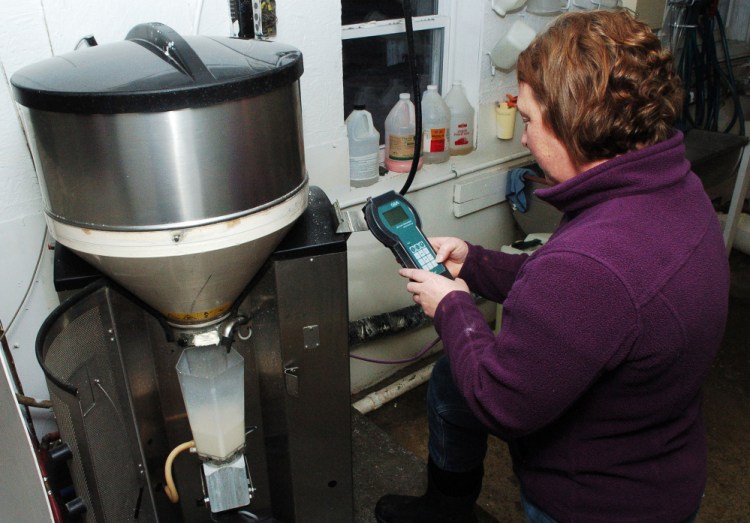A small calf steps up to an opening on one wall of the barn at Aghaloma Farms in Knox, sticking its head through the metal-lined opening that’s shaped like an oval pulled outward in the middle, and clamps onto a small tube.
In the small room next to the calf area, a machine is funneling milk replacer through the tube to the calf. Once the calf has had 5 quarts of the liquid, the machine will stop sending the food its way.
When the calf enters the area to reach the computerized milk dispenser system, flanked by two guard rails, a black sensor box on its left reads a yellow chip in the calf’s left ear. The program keeps track of each calf separately, monitoring how much they drink. None are given more than 5 quarts and if they drink less, the farmers know to check up on them.

A calf drinks a milk replacement that comes from a computerized dispenser programmed for each calf at Aghaloma Farm in Knox. The milk machine reads information from the round computer chip on the calf’s left ear. David Leaming/Morning Sentinel
Aghaloma Farms is one of a few dozen farms in Maine that have folded automated farm technology into their routines.
One of the newest to embrace the technology is Misty Meadows Farm in Clinton. The farm, which has been a Maine Farm Days host for years, is busy installing the calf-feeding technology this December with the hopes the new system will be up and running by January. Kimberly Wright, a co-owner of the farm, said the project has been “a year in the making,” partly due to research and partly due to construction.
While Maine farmers may be embracing automatic feeders, they are slow to take on one kind of technology that has expanded internationally – automatic milking.
While on his sabbatical in Europe more than a year ago, Richard Kersbergen, a professor for the University of Maine Cooperative Extension, said he found that about half of Netherlands farms use “robots” to milk their cows. Farms in Vermont and New Hampshire are using that technology to save time and improve cow behavior, he said, but as of now no farmers in Maine have a machine for automated milking.
“In Maine, there’s a lot of interest, but no one wants to be the first,” Kersbergen said. “You want to make sure you’ve got the technical support nearby, and right now the nearest technical support is in Vermont.”

Evan Fisher pours buckets of formula to be fed to the calves as TJ Wright, right, helps at Misty Meadows Farm on Clinton on Friday. Michael G. Seamans/Morning Sentinel
At Misty Meadows, the calves are kept in hutches, or small plastic or wooden structures that can hold one calf, sometimes more. But soon they’ll be moved to a single structure the farmers built to incorporate the automatic calf feeders. Wright said they are hopeful the automation will make the farm more efficient.
“Winters in Maine are not easy at all. The calves in hutches are really labor-intensive,” she said. “Like any industry, efficiency is becoming your only way to survive.”
In order to justify a technician living in Maine, enough farms would have to employ the technology first, Kersbergen said, which has its own barriers. All told, it can cost $250,000 after the farm builds a new structure to facilitate the milking robot.
But Kersbergen said the technology shows significant benefits, too.
“You also reduce your labor costs considerably,” he said. Most systems also store data on each animal, which can be extremely useful for farmers.
The cows seem to like the robots better, too, Kersbergen said.
“Behaviorwise, it’s just an incredible difference,” he said. “Cows are creatures of habit. They like consistency. There’s a lot more consistency with a robot than there is with a human, because they’re going to get milked the exact same way each time.”
The cows also have more free will with automated systems — they go to the robot when they want to be milked, not the other way around.
“You’ll find that it’s just incredibly quiet and calm in there,” Kersbergen said.
Copy the Story LinkSend questions/comments to the editors.




Success. Please wait for the page to reload. If the page does not reload within 5 seconds, please refresh the page.
Enter your email and password to access comments.
Hi, to comment on stories you must . This profile is in addition to your subscription and website login.
Already have a commenting profile? .
Invalid username/password.
Please check your email to confirm and complete your registration.
Only subscribers are eligible to post comments. Please subscribe or login first for digital access. Here’s why.
Use the form below to reset your password. When you've submitted your account email, we will send an email with a reset code.